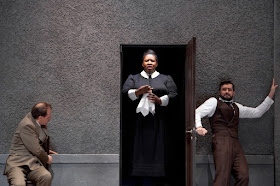Philharmonie
Mass in B minor, BWV 232
Yetzabel Arias Fernandez (soprano)
Wiebke Lehmkuhl (contralto)
Tilman Lichdi (tenor)
Klaus Mertens (bass)
RIAS Chamber Choir (chorus master: Justin Doyle)
Berlin Philharmonic Orchestra
Ton Koopman (conductor)
Theodor Adorno: how I wish we
could have heard your thoughts on this concert. In his 1951 essay, ‘Bach
defended against his devotees’, written in the wake of the commemorations of
the bicentenary of Bach’s death, Adorno so sharply characterised the reactionary
delusions and disingenuities of musical ‘authenticity’ that one might well have
thought that would have been the end of that. Except, of course, that it was
not; we had barely reached the end of the overture. Vast swathes of repertoire
have been entirely colonised, placed off-bounds to modern orchestras in the
maniacal name of an ‘authenticity’ so self-contradictory that a five-year-old
could instantly demolish its claims. And yet, so it continues. It was, then,
with great interest that, two-thirds of a century after Adorno’s essay, I
approached the rare opportunity of hearing the Berlin Philharmonic in the B
minor Mass.
Not, alas, that this was a
large-scale, ‘symphonic’ performance. (‘Symphonic’ is an especially silly word
here: as if Klemperer or Jochum approached Bach as they did Beethoven…) The
opening of the first Kyrie was,
rather to my surprise, not at all brusque, although the chamber-scale of the
forces – not small by contemporary (to us) standards, although certainly small
by Adorno’s – immediately struck me, not least given the size of Berlin’s
Philharmonie. After the tempo change – call that Largo?! – however, Ton Koopman’s approach proved both glib and
metronomic: not unlike his strangely uncompelling way with the organ. A plea
for divine mercy? Forget it. Perhaps a request for afternoon tea, although even
that might have been to impart too much meaning. And therein lay the real
problem. The musicians playing and singing were nearly all excellent: the
Philharmonic, the Berlin Radio Choir, and at least two of the vocal soloists.
But they were directed by someone who seemed not just to have a decidedly peculiar
sense of what the text of the Mass might mean; he seemed to have none
whatsoever. And here, as throughout the work, he simply took the piece one archly
articulated phrase at a time, giving no indication of a longer line, let alone
a unified conception. Even dynamic contrasts were minimal – and, when they were
to be heard, weirdly arbitrary. The following ‘Christe’, then, however beautifully
sung by Yetzabel Arias Fernandez, might on Koopman’s part have been computer
generated – or, to return us to the 1950s, ‘sewing-machine Bach’. The second ‘Kyrie’,
the clarity of choral lines remarkable in itself, sounded as a mere pendant.
Parts of the ‘Gloria’ fared
better. The first section was hardly profound, and suffered from fussy articulation,
but it more or less looked after itself. Moreover, much to my surprise, the ‘Et
in terra pax’ section relaxed properly, even daringly, as did the ‘Gratias’.
And yet, whilst instrumental obbligato parts were all very well taken (Emmanuel
Pahud on flute, for instance), most of the vocal solos likewise – Wiebke Lehmkuhl’s
‘Qui sedes’ an object lesson in sounding imploring without sentimentality –
there was never any sign of an overall conception. When musicians were allowed
to get on with it, they generally did very well indeed; often, however, they
seemed circumscribed. To return to Adorno’s essay, one could hardly
avoid the suspicion that the sole concern of Bach’s ‘devotee’ was to ensure
that ‘no inauthentic dynamics, no modifications of tempo, no excessively large
choirs and orchestra’ should be employed. Is that your idea of Bach, I wanted
to ask? Bach’s scoring of genius in the ‘Quoniam’ told properly, the bassoonists
shining just as brightly as the horn player; it was a pity, here and later,
that Klaus Mertens sounded so dry of tone, and that he faltered so audibly at
one point. His tenor colleague, Tilman Lichdi fared better, but his light
instrument – or performance – was put in the shade by Arias during their duet.
The Cum sancto Spiritu’ was, to no one’s surprise, taken at breackneck speed.
Whilst the choir acquitted itself with distinction, the question that lingered
was: ‘why?’
Following the interval, an almost aggressively domesticated ‘Credo’ –
without the ‘almost’, it might ‘almost’ have been interesting – signaled little
more than the sense that the conductor might have a train to catch at the end.
Everything sounded as if it were surface; that Bach might have held beliefs,
even held them to be eternal truths, that we might need in some sense to reckon
with that, with them, seemed never to have been considered by Koopman. If your
vision of Resurrection is in pastel, then the ‘Confiteor’ and what immediately
followed might have been for you. The ‘Sanctus’ can rarely have sounded less
like the swing of a censer, Koopman unwilling to let go, stopping it at the end
of every phrase so as to permit it to move another few inches. As for his
decision to play the organ himself for the ‘Benedictus’, it added a
disconcerting sense of the listless, of the merely meandering, but is that what
the coming of the Holy Ghost should signify? Following a bar-to-bar, highly laboured
‘Agnus Dei’, very well sung on its own terms, an effort towards mild grandeur
was made in the closing ‘Dona nobis pacem’. It was unclear, though, where it
had come from, or what it might denote.
‘They say Bach, mean Telemann,’
was one of Adorno’s most devastating charges. Bach was being reduced to the
level of a generic ‘Baroque’ composer. (Telemann devotees should feel free to choose
someone else; there are more than enough to choose from.) The problem with
Koopman was not that he said Bach yet meant Telemann; he did not seem to mean
anyone or anything at all.












